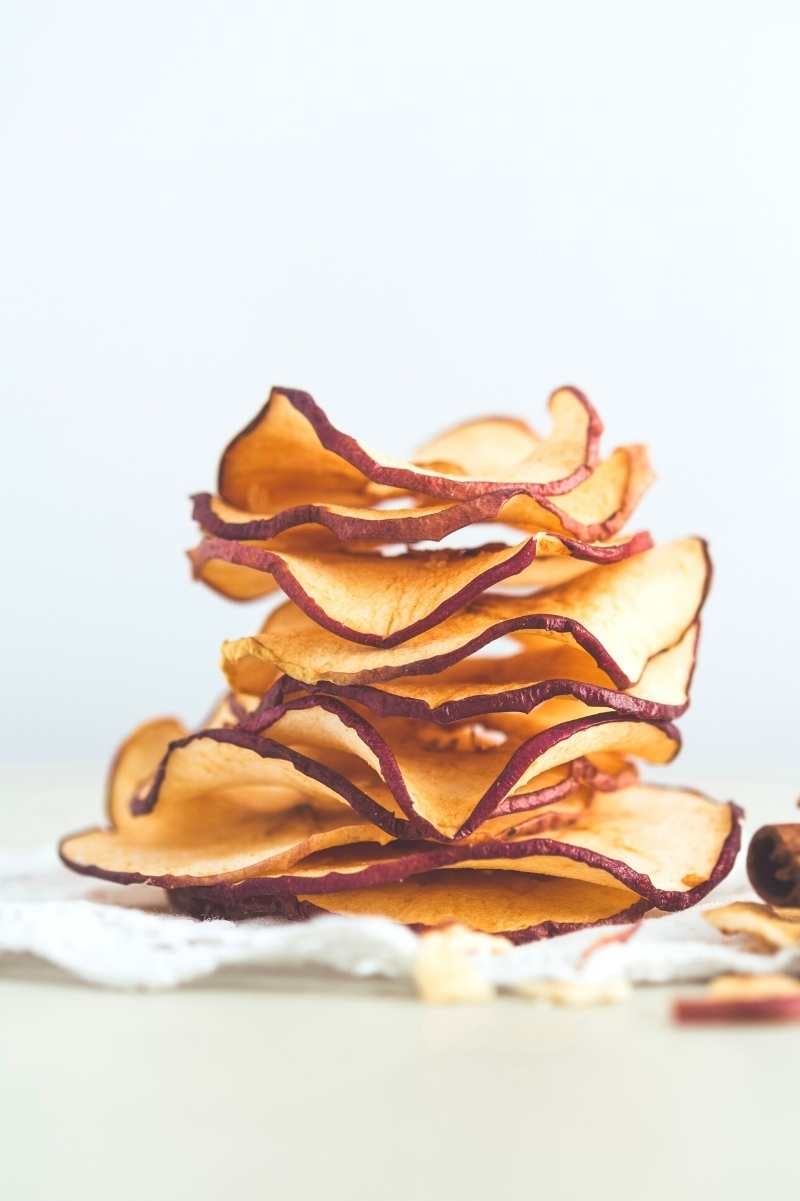Heading out to an orchard to pick apples is a must-do for our family each fall! I always make sure to grab way more apples than my family could ever eat fresh, and that’s because apples are a darling of food preservation. There are lots of ways to stash your apple bounty for later enjoyment, but one of my faves is dehydrating! Dried apples are tasty, easy-to-make and super versatile.
Learning how to dehydrate apples is super simple. You can use an oven, a dehydrator, or even the power of the sun. Dehydrating apples allows you to preserve them through the long winter months and into the spring. Dehydrated apples are crisp, sweet, and delicious. Let’s get drying!
The Ultimate Guide to Healthy School Lunches
We’ve packed (pun intended!) all our knowledge from years of making school lunches into one digital master guide!
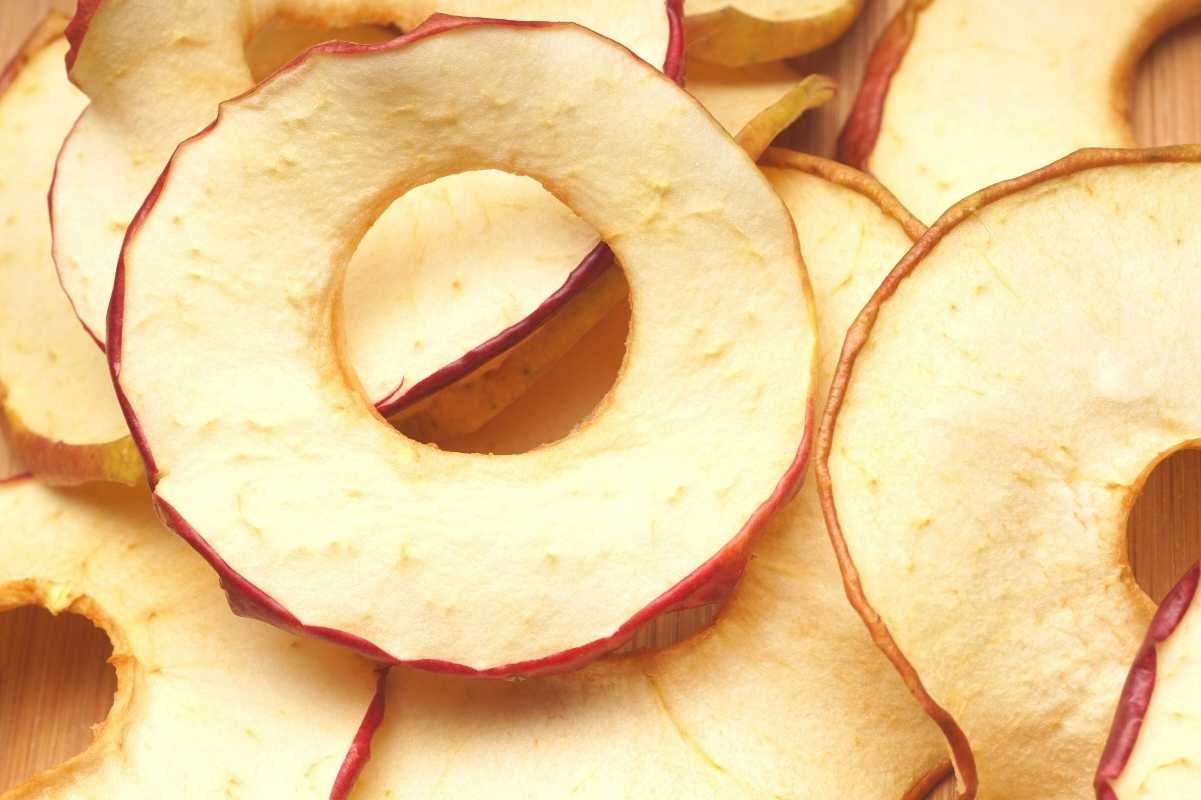
What type of apple is best for dehydrating?
It all comes down to availability and taste. Honestly, every apple can be dehydrated, so whatever you have on hand will work perfectly! If you prefer an apple that’s tart, then you can’t go wrong with a McIntosh or Granny Smith. However, if you have a sweet tooth, Fuji, Honeycrisp, Red Delicious, and Gala are all great options.
Do you have to use lemon juice to dehydrate apples?
Not necessarily—you can also use something like Ball® Fruit Fresh. But you will want to treat the cut apple slices with some sort of acid before you dehydrate them. Otherwise, you’ll end up with very brown dehydrated apple chips. To use lemon juice, mix up a diluted lemon solution by adding one tablespoon of lemon juice for each cup of water needed to cover the apple slices.
Do I need to remove the skin of my apples?
This all comes down to personal preference. Your apples will dehydrate well with or without the skin. If you prefer to have no skin on your dried apples, just take a vegetable peeler and peel it off before dehydrating. We personally prefer to leave the skin on because the color is beautiful, the skin is full of nutrients, and—let’s be honest—it saves us a step!
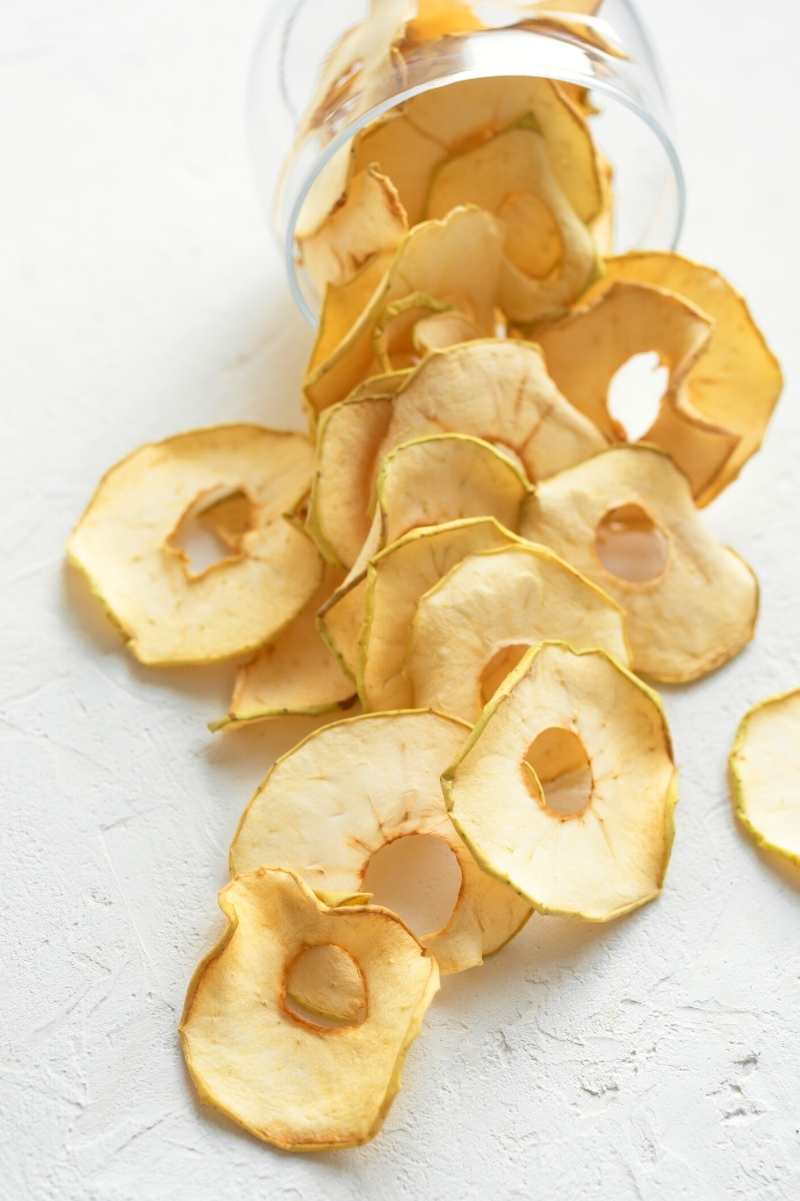
Is one method of dehydrating apples better than the others?
Not really. Using a dehydrator, an oven, and the sun all work well. Of course, each method has its pros and cons. Let’s go over those so you can pick your favorite:
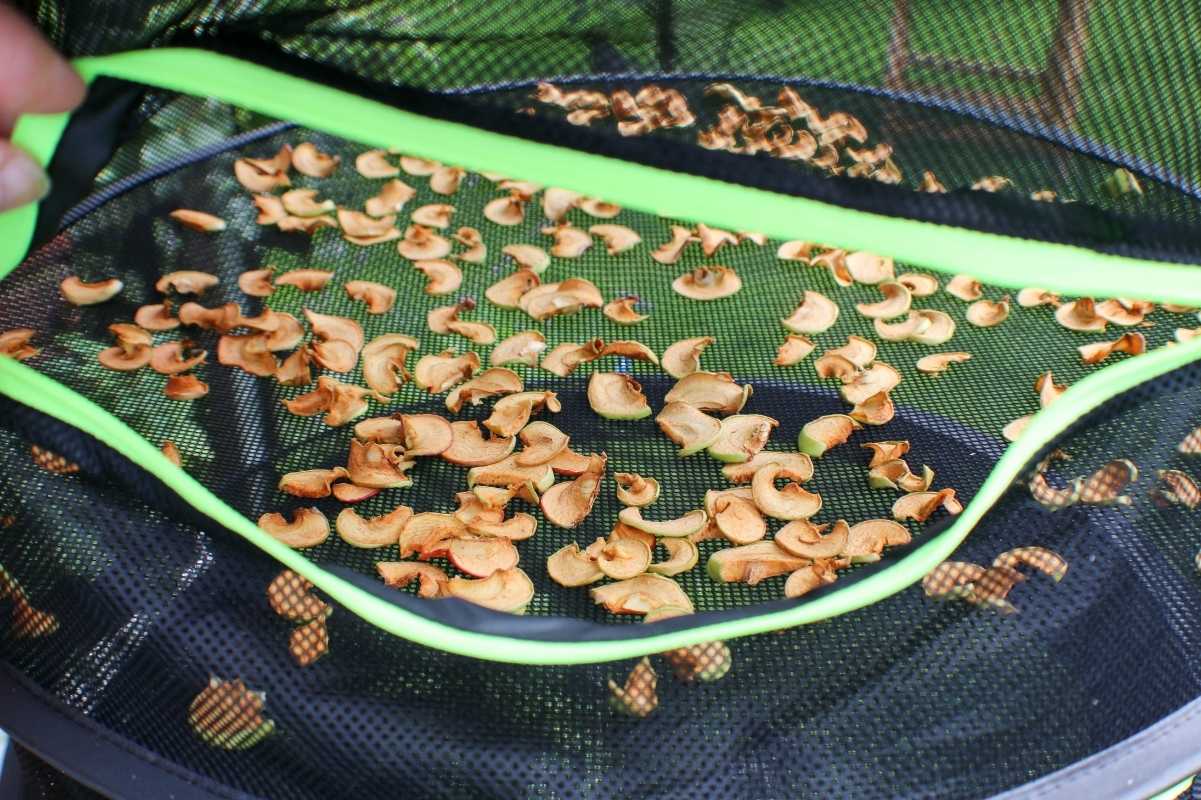
Sun Drying
Sun-dried apples are a traditional method for dehydrating. If you live in a suitable climate and have a stretch of nice sunny, dry days, this method is guaranteed to produce delicious and flavorful apple slices.
Pros:
- Straight-forward. Beginners who are just learning how to dehydrate apples shouldn’t have too much trouble with this method.
- Not much equipment needed. Sun drying requires the least amount of equipment.
Cons:
- Hard to control. To properly dry your apples in the sun you need to live in a hot, dry climate. The sun also has to reliably shine for several days in a row. This makes sun drying hard to control—we all know we can’t control the weather! This is especially hard for those of us who live in an area with high humidity or damp fall.
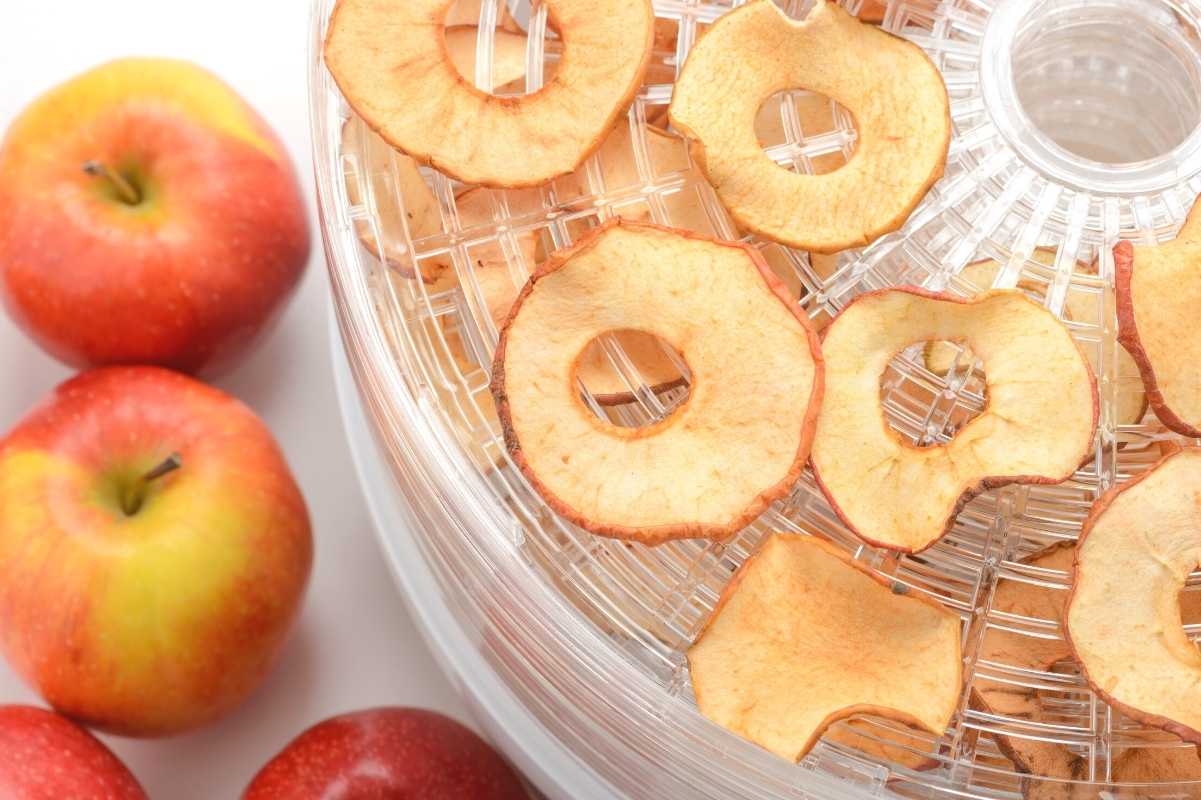
Dehydrator
When you’re just learning how to dehydrate apples, you might want to try using a dehydrator. While it does require special equipment (ahem, a dehydrator), it takes all the guesswork out of the process, making drying apples fool-proof!
Pros:
- Simple. This dehydrating method is probably the easiest for a beginner because it’s a very controlled environment, and you can choose your temperature.
Cons:
- Special equipment required. This method could be the most expensive if you need to purchase a food dehydrator before you begin.
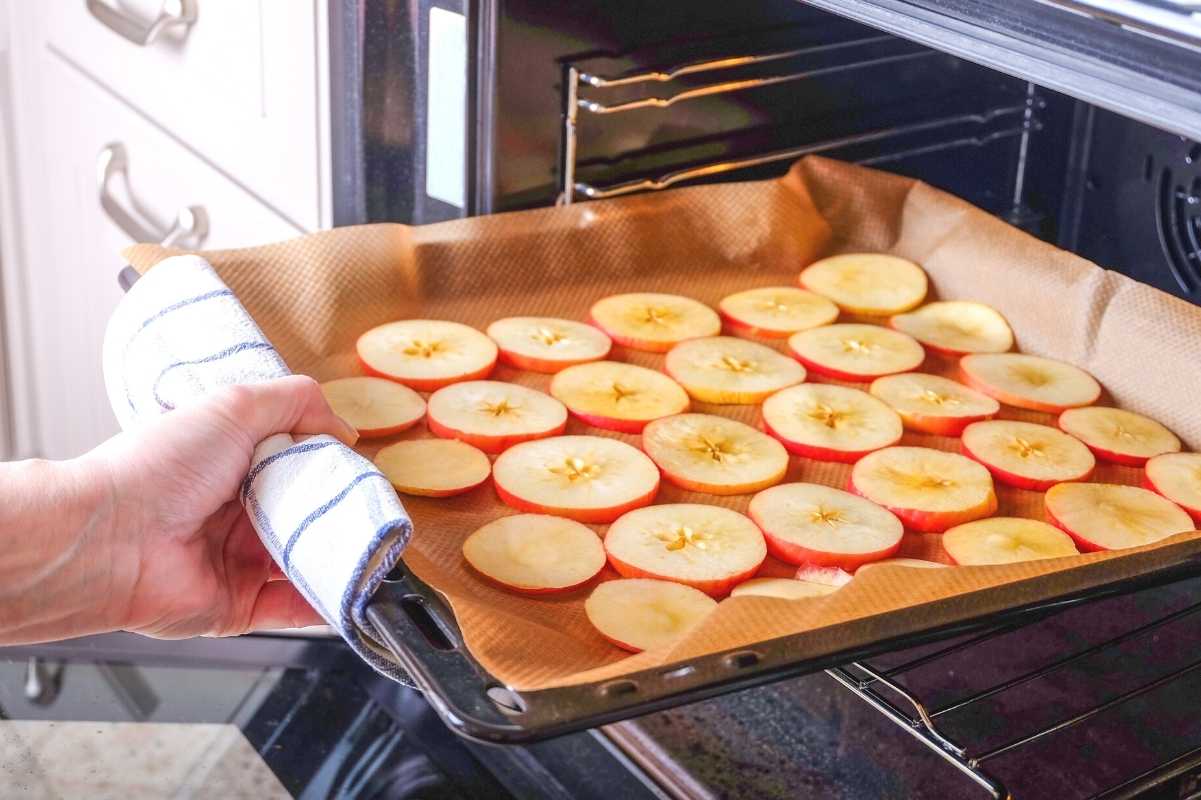
Oven Drying
Dehydrating apples in your oven is a good middle ground if you want a more controlled environment than sun-drying, but don’t want to purchase a new appliance for your kitchen.
Pros:
- Accessible. Most of us have an oven, which makes this method pretty easy for someone learning how to dehydrate apples.
Cons:
- Risk of burning. The problem you might encounter with oven drying is that not everyone’s oven goes as low as 160°F. If you’re in this boat, you might have to check on your apples more frequently to ensure they’re not drying too fast or baking instead of dehydrating.
- Ties up your oven. If you’re drying multiple trays of apples, this could tie up your oven for hours, which is fine in some kitchens, but maybe not if you are a heavy user of your oven.
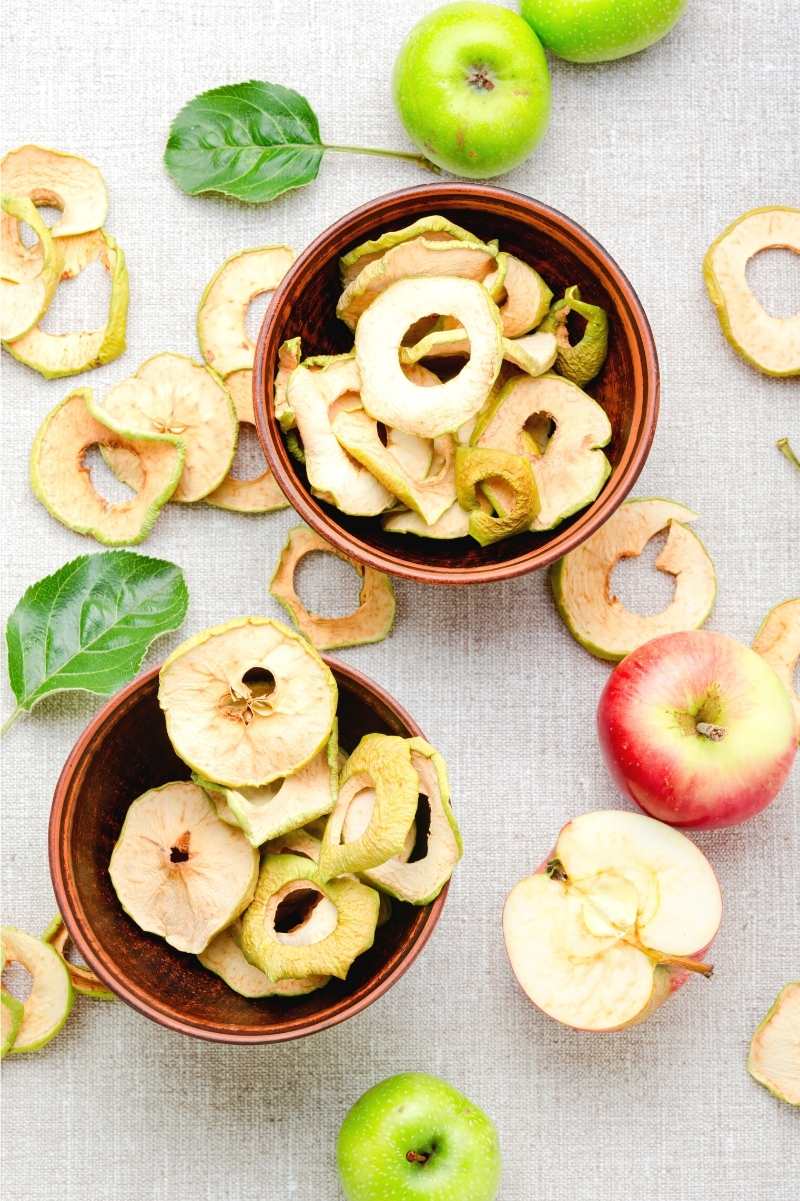
Teach me how to dehydrate apples in the oven!
Most of us have an oven at home, making this method a great choice if you aren’t all-in on dehydrating as a preservation method yet. To dry apples in the oven:
- Preheat the oven to 160°F. If your oven doesn’t go that low, set it to its lowest possible temperature instead. Plan to check on your apples several times for burning if the temp is higher than 160°F.
- Core and slice your apples. Treat the slices with lemon juice or Ball® Fruit Fresh to prevent browning.
- Spread the treated apple slices in a single layer on a wire baking rack set in a rimmed baking sheet.
- Bake the apples at a low temperature in the oven for several hours, until dry and pliable.
Tell me about dehydrating apples in a dehydrator.
Using a food dehydrator is the most hands-off method for drying apples. Here’s what you’ll do:
- Core and slice your apples, and treat the slices to prevent browning.
- Lay the apple slices in a single layer on the dehydrator trays.
- Dry the apples in the dehydrator at 160°F, until dry and pliable.
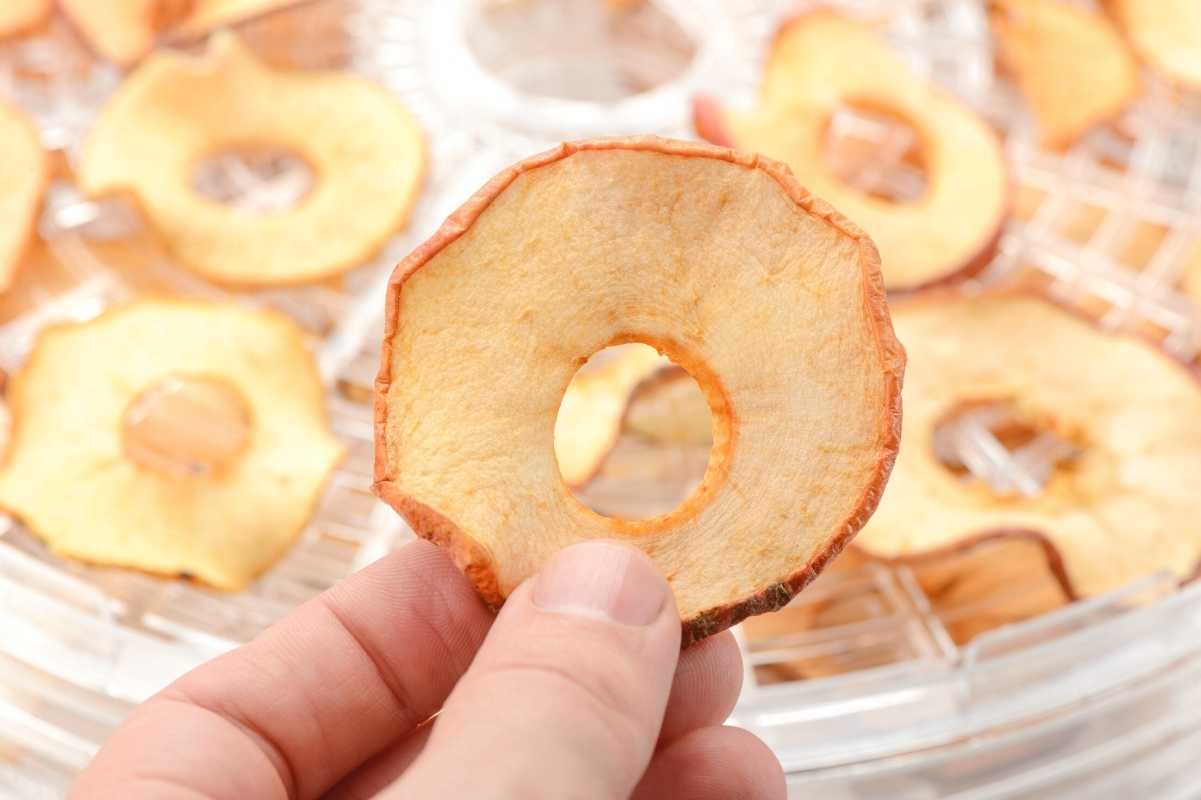
Can you teach me how to dehydrate apples by sun drying them?
The weather has to be juuuuuust right to successfully sun dry apples—you need low humidity, warmth, and sun. But if your weather is right, here’s what to do:
- Core and slice apples, and treat them for browning prevention with Ball® Fruit Fresh or lemon juice.
- Spread the apple slices in a single layer on a cooling rack set on top of a rimmed cookie sheet.
- Place the apples in the sun somewhere where they will get good air circulation and are out of reach of pests. We often use insect netting over our trays to keep bugs out. Dry for several hours to several days, until apples are dry and pliable.
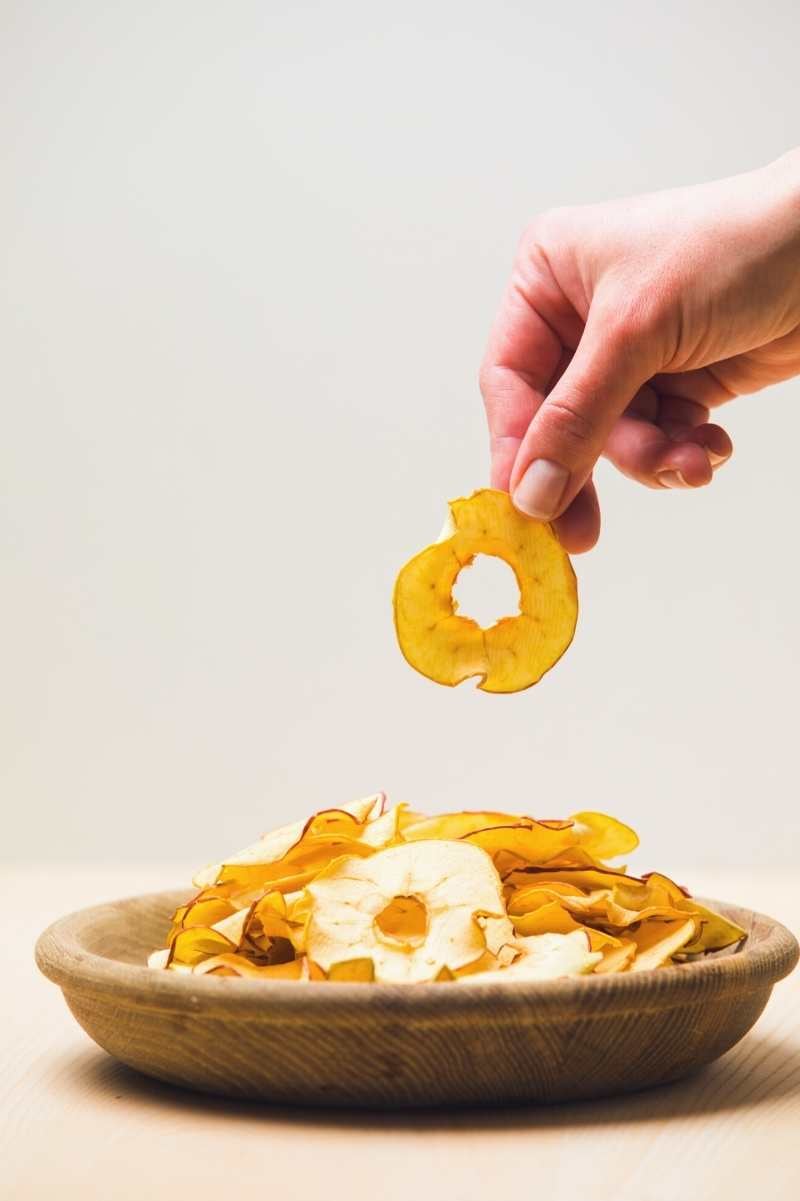
What is the best food dehydrator?
There are a lot of fancy, pricy food dehydrators out there, but we’ve used this more accessible Nesco Snackmaster Food Dehydrator for years and have been very happy with it. It costs less than $100, and you can expand it to hold up to 12 trays if you want to do a lot of drying!
How long do you put apples in a dehydrator?
The answer depends on several factors, including your dehydrator’s make and model, the thickness of your apple slices, and the humidity in your environment. As a general rule of thumb, set your dehydrator to around 160°F and check on the apples after a few hours. Keep an eye on them and check for doneness every hour or so. You’ll know they’re ready when they’re pliable, with no visible moisture.
Can I use these methods to make apple chips?
You absolutely can! Apple chips are just thinly sliced apples that are dried until they are crisp. Just extend the dehydrating process until the apples are crisp and snap when bent. We recommend thin slices (about 1/8″ in thickness) for apple chips, but you can also experiment with going even thinner (down to 1/16″).
Wholefully Protip
Dehydrated foods always seem softer when right out of the food dehydrator. To really test the crispness, let the food cool first, then test.
Can I increase the temperature to speed up the dehydrating time?
I wouldn’t recommend it. In the best case, this will cause your apples to steam and cook instead of dehydrate. In the worst case, turning the temperature up will cause your apples to dry way too quickly on the outside, while leaving the inside soft and wet. This is a recipe for mold during storage. Slow and steady is the key to delicious dehydrated apples.
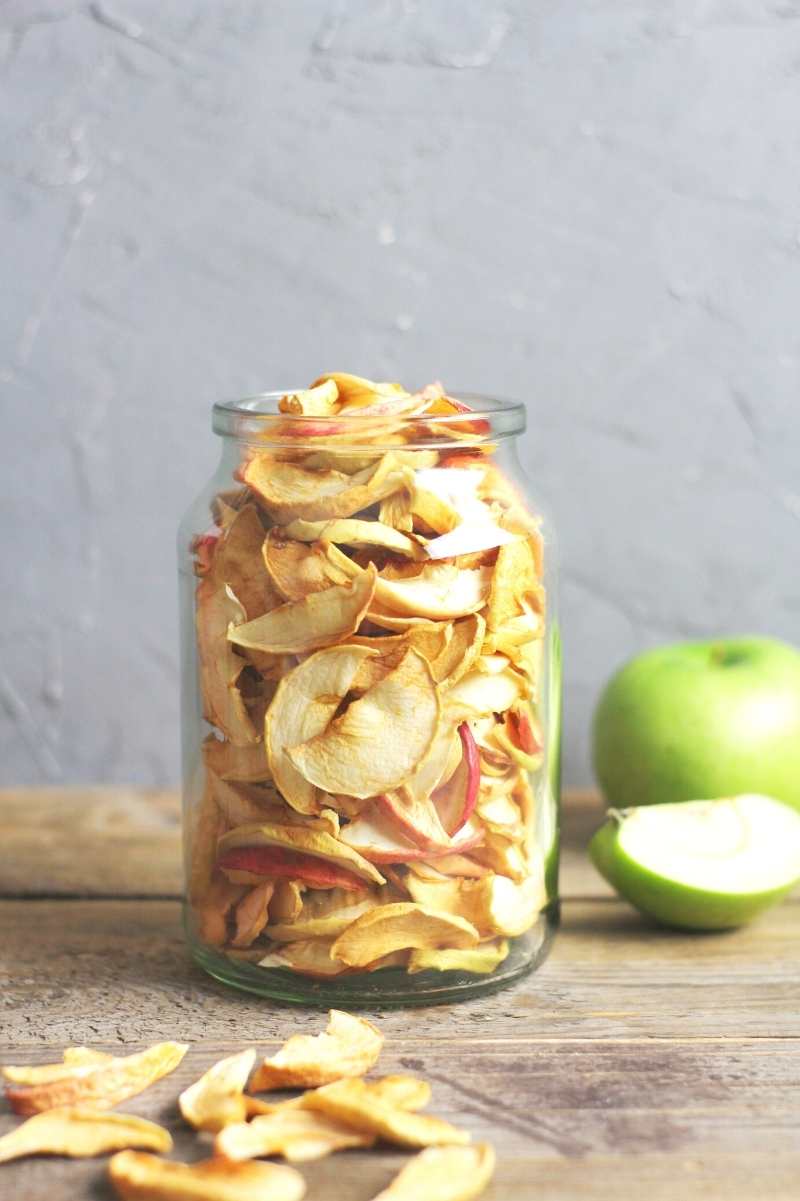
Can I cut my apples thinner to speed up drying time?
In general, no. Just like you can’t cut corners by increasing the drying time, trying to rush the process by cutting thin slices will backfire on you. You want the pieces to be thin enough that they dry, but if they’re too thin, you run the risk of them burning and becoming too crunchy. Super thin apple slices also tend to stick to the tray of your dehydrator if you’re using this method. In the end, you want your apple slices to be crispy but still slightly pliable.
The one exception here is if you want to make crispy, crunchy apple chips. Then we recommend thin slices (about 1/8″ in thickness).

Why did my apples turn brown?
Apples go brown because the enzymes in the apples react to the oxygen in the air. The good news is, brown apples are still perfectly healthy to eat. If you prefer not to have brown apple slices, it’s important to soak your pieces in a solution to prevent browning before you dehydrate them. We use either Ball® Fruit Fresh or lemon water (a mixture of 1 tablespoon lemon juice per 1 cup of water).
What’s the best way to store your dehydrated apples?
Dehydrated apples should be stored in clean, dry, airtight containers. Canning jars work really well for this, and you can pack quite a few slices in your jars. Once in jars, your apples should be kept in a cool, dry, dark location such as a basement or a root cellar for longer storage.
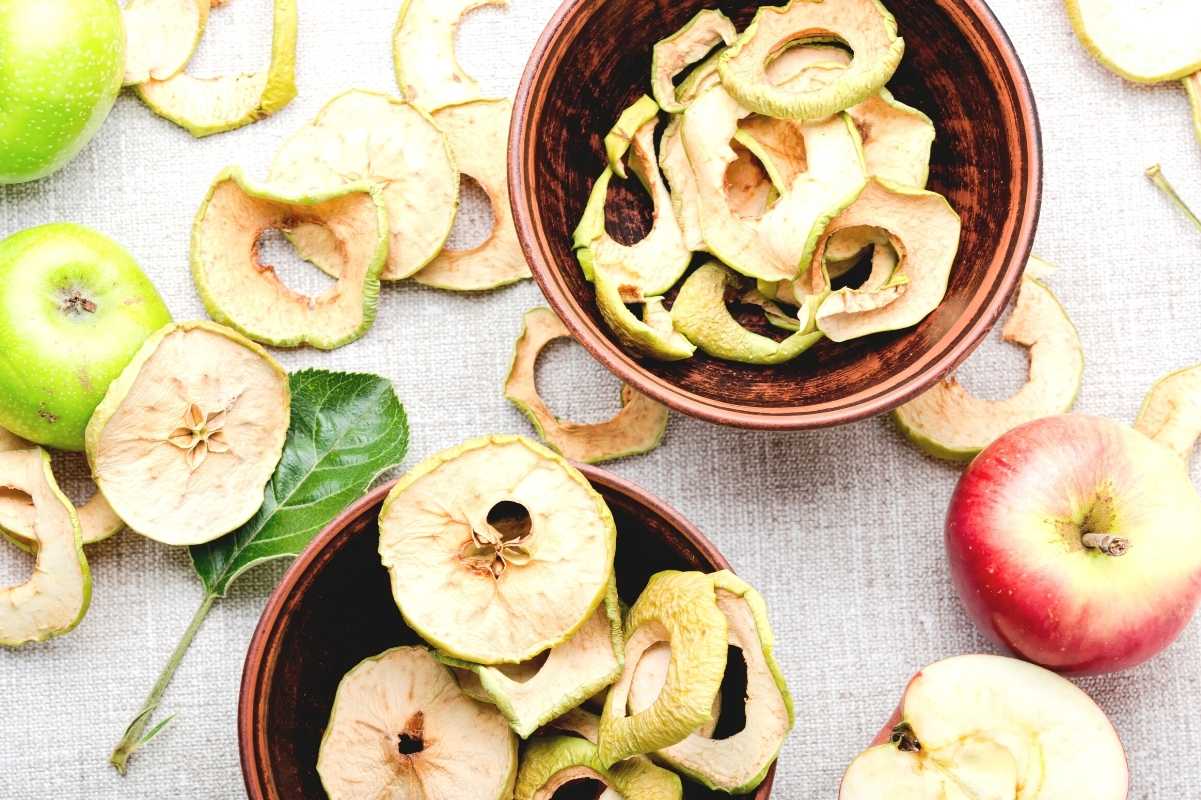
How long will dehydrated apples last?
Appropriately stored, you can enjoy your crisp, dehydrated apples for 6-8 months at room temperature, as long as they’ve been properly dehydrated. However, if you’d like to store them for longer than that, popping them in the freezer can extend their shelf life.
How can I use dehydrated apples?
Dehydrated apples are a great snack all on their own! But you can also use them in oatmeal, granola, or trail mix.
Can you re-hydrate dried apples?
Yes! Although these snacks are delicious when dehydrated, you can definitely add moisture back into them if you need some apples for cakes, muffins, or pies. To re-hydrate your dried apple slices, you can soak them in a bowl of room temperature water for half an hour until they’re plump and soft.
Alternatively, you could also bring a cup of water to a boil, add a cup of dehydrated apples, and boil for 5-8 minutes. If you want to inject even more flavor into your apples, you could use juice in place of water to re-hydrate your apples.
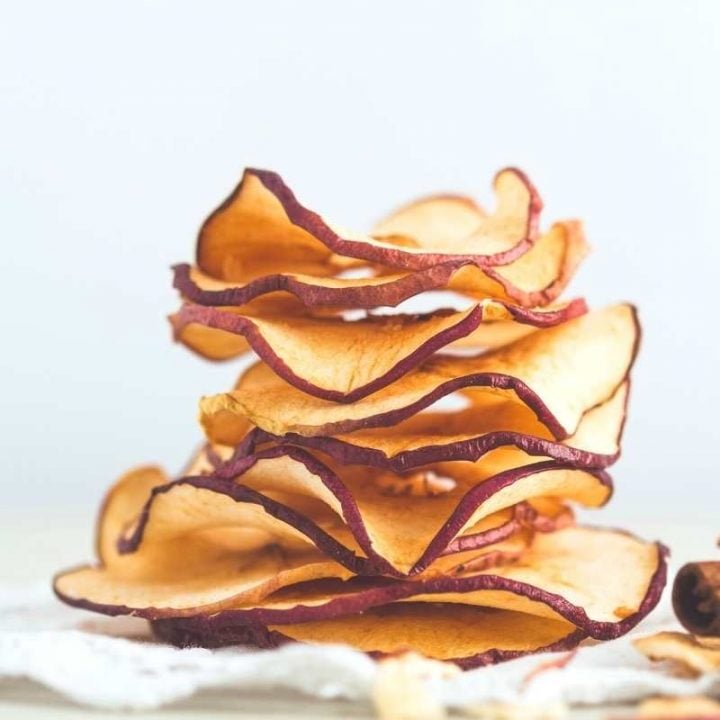
How To Dehydrate Apples
Dehydrating apples is a great way to preserve fruit all year long. We'll show you 3 easy methods for dehydrating apples.
Ingredients
- 6 pounds apples
- Ball Fruit Fresh or lemon juice
Instructions
Dehydrator
- Core apples and cut into thin slices. A mandoline slicer is the best option for this.
- Treat the apples using a browning prevention. You can use Ball® Fruit Fresh or 1 tablespoon of lemon juice per cup of water.
- Place the apple slices in a single layer on dehydrator trays.
- Dry the apples in the dehydrator at 160°F. It will take several hours for the apples to dry, and the exact time will depend on the size of your apple slices, the humidity in the air, and other considerations.
- Your apples are finished when they are dry, but still slightly pliable. If you like crispy dried apples, you can continue drying them until they are completely dry and crisp.
Oven-Dried
- Preheat your oven to 160°F. If your oven doesn’t go that low, preheat it to as low as it will go, but know that you’ll need to keep a close eye on your apples to prevent burning and baking.
- Core apples and cut into thin slices. A mandoline slicer is the best option for this.
- Treat the apples using a browning prevention. You can use Ball® Fruit Fresh or 1 tablespoon of lemon juice per cup of water.
- Place a baking rack inside a rimmed baking sheet. Place the apples in a single layer on the baking rack.
- Dry the apples in the oven. It can help to flip your apple slices over halfway through the drying process. If you have a few trays of apples in your oven, crack the oven door to allow for better circulation.
- It will take several hours for the apples to dry, but the exact time will depend on the size of your apple slices, the humidity in the air, and other considerations.
- Your apples are finished when they are dry, but still slightly pliable. If you like crispy dried apples, you can continue drying them until they are completely dry and crisp.
Sun-Dried
- Sun dry apples only when warm, dry, sunny weather is expected for several days. If you live in a high-humidity region, sun-drying may not be right for you.
- Core apples and cut into thin slices. A mandoline slicer is the best option for this.
- Treat the apples using a browning prevention. You can use Ball® Fruit Fresh or 1 tablespoon of lemon juice per cup of water.
- Place a baking rack inside a rimmed baking sheet or use large screens set up outside for circulation. Place the apples in a single layer on the baking rack or screens.
- Place the apples in a sunny spot with good circulation, away from where critters can get to them. You may want to cover your apples with insect netting to prevent insects from getting into them.
- It will take several hours to days for the apples to dry, but the exact time will depend on the size of your apples, the humidity in the air, and other considerations.
- Your apples are finished when they are dry, but still slightly pliable. If you like crispy dried apples, you can continue drying them until they are completely dry and crisp.
Notes
- To store apples: store them in an airtight container (we like to use canning jars) in a dark, cool part of your pantry. If properly dried, they’ll last for 6-8 months. To ensure a longer shelf life, store in the freezer.
Nutrition Information:
Yield: 12 Serving Size: 1Amount Per Serving: Calories: 126Total Fat: 0gSaturated Fat: 0gTrans Fat: 0gUnsaturated Fat: 0gCholesterol: 0mgSodium: 3mgCarbohydrates: 33gFiber: 6gSugar: 25gProtein: 1g
At Wholefully, we believe that good nutrition is about much more than just the numbers on the nutrition facts panel. Please use the above information as only a small part of what helps you decide what foods are nourishing for you.

